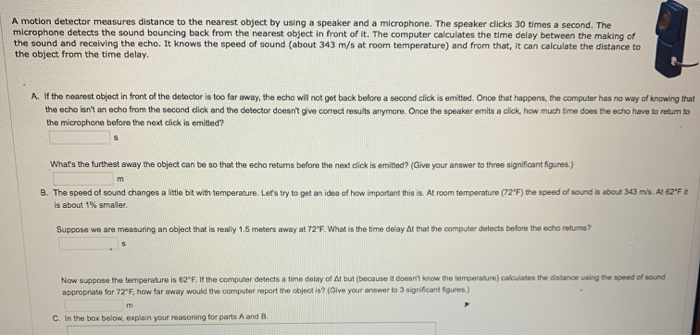Answered step by step
Verified Expert Solution
Question
1 Approved Answer
A motion detector measures distance to the nearest object by using a speaker and a microphone. The speaker clicks 30 times a second. The

A motion detector measures distance to the nearest object by using a speaker and a microphone. The speaker clicks 30 times a second. The microphone detects the sound bouncing back from the nearest object in front of it. The computer calculates the time delay between the making of the sound and receiving the echo. It knows the speed of sound (about 343 m/s at room temperature) and from that, it can calculate the distance to the object from the time delay. A. If the nearest object in front of the detector is too far away, the echo will not get back before a second click is emitted. Once that happens, the computer has no way of knowing that the echo isn't an echo from the second click and the detector doesn't give correct results anymore. Once the speaker emits a click, how much time does the echo have to return to the microphone before the next click is emitted? What's the furthest away the object can be so that the echo returns before the next click is emitted? (Give your answer to three significant figures.) m B. The speed of sound changes a little bit with temperature. Let's try to get an idea of how important this is. At room temperature (72F) the speed of sound is about 343 m/s. At 62F it about 1% smaller. is Suppose we are measuring an object that is really 1.5 meters away at 72F. What is the time delay At that the computer detects before the echo returns? Now suppose the temperature is 62F. If the computer detects a time delay of At but (because it doesn't know the temperature) calculates the distance using the speed of sound appropriate for 72F, how far away would the computer report the object is? (Give your answer to 3 significant figures.) m C. In the box below, explain your reasoning for parts A and B.
Step by Step Solution
There are 3 Steps involved in it
Step: 1

Get Instant Access to Expert-Tailored Solutions
See step-by-step solutions with expert insights and AI powered tools for academic success
Step: 2

Step: 3

Ace Your Homework with AI
Get the answers you need in no time with our AI-driven, step-by-step assistance
Get Started


